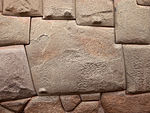Territorial Style

Territorial Style was an
US state. Following the increase of its popularity in the 1930s and 1940s, it became referred to as the Territorial Revival style, which became another popular building style alongside New Mexico's Pueblo Revival
style.
Vernacular

A vernacular subgroup, from 1860 to 1935, of the Territorial Style is known as the Folk Territorial, Folk Carpenter, and Spanish Folk Territorial. The style was found "particularly in Northern New Mexico", and consisted of applied wood
Gothic details of the Spanish missions in New Mexico, added to the building styles of the Pueblo architecture the Northern New Mexico adobe building construction style.[3]
Later development by Anglo-Americans
When the Americans, under General
Mexican territory than the first view of this town."[5] The city of Santa Fe did not inspire any more admiration, "one traveler likened it to 'a dilapidated brick kiln or a prairie dog town."[6]
Soon "increasing numbers of

The Anglos did three things to the
dentils
in the courses.

To further simulate a Greek Revival appearance the Anglos replaced the round tree trunk
bases
.
Finally the Anglos introduced the
pitched roof and the material to produce them. The ternplate roof was a metal one, made in strips and composed of an alloy of tin and lead. Manufactured in the East, the strips were designed to be soldered together, producing a roof much longer lasting and much less leaky than the flat roofs that were commonly used.[8]
Reintroduction
The style remained in use until 1900. It came back into use in 1930 in the form of Territorial Revival architecture.
References
- ISBN 978-0-313-32805-3. Retrieved February 16, 2021.
- ^ Bunting, Bainbridge, ‘’Early Architecture in New Mexico’’, University of New Mexico Press, Albuquerque 1976 p. 88
- ^ New Mexico State Historic Preservation Office guidelines of architectural styles in the New Mexico. P. 28
- ISBN 0-8263-1690-5.
- ISBN 0-8263-1698-0. Archived from the originalon 2002-10-25.
- ^ ISBN 0826317464.
- ISBN 0-403-02181-2.
- ^ a b c Conron and Lent (1979). "The Architecture of Santa Fe: A Survey of Styles". New Mexico Architecture: 14–15.

